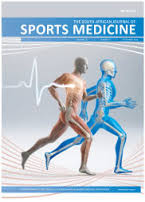Evolving injury profiles amid advancing sport: Musculoskeletal injuries in ringball players
DOI:
https://doi.org/10.17159/2078-516X/2020/v32i1a8166Abstract
Background: Ringball, a sport historically derived from conventional basketball and netball, demonstrates the evolution of traditional sport. The variations between these sports may predispose players to different risk factors and consequent injuries and their impact, yet they are usually considered comparably.
Objective: To determine the prevalence of musculoskeletal injuries and to profile injuries based on location, severity, and mechanisms of occurrence. A further objective was to compare the injuries sustained in ringball with that of basketball and netball.
Methods: A questionnaire-based study, administered to 110 ringball players in KwaZulu-Natal, South Africa, was applied. Data were described and compared using frequencies/ percentages for categorical variables.
Results: Seventy-six ringball players completed the questionnaire (69% response rate). The prevalence of at least one injury during/after the last or current season was 80% (n=61). The most commonly reported injury was to the foot/ankle (36%; n=33) followed by the knee (29%; n=27) and wrist (9%; n=8). The most common mechanisms of injury reported were landing (15%; n=9), jumping (9%; n=5), goal shooting (7%; n=4), defending (7%; n=4) and collision (7%; n=4).
Discussion: Ringball shares similar injuries to that of basketball/netball, with foot/ankle injuries being the most prevalent. The prevalence of other injuries in ringball differed from basketball/netball, suggesting variations between these sports as a contributor to the injuries described.
Conclusion: The evolution of sport and the modifications in rules/techniques may create a nuanced injury profile to those commonly identified. The combination of a sport’s uniqueness/modification and its similarities to other sports warrants the need for more tailored approaches to injury prevention and a platform for future research.
Downloads
Downloads
Published
Issue
Section
License
Copyright (c) 2020 South African Journal of Sports Medicine

This work is licensed under a Creative Commons Attribution 4.0 International License.
The South African Journal of Sports Medicine reserves copyright of the material published. The work is licensed under a Creative Commons Attribution 4.0 (CC BY 4.0) International License. Material submitted for publication in the South African Journal of Sports Medicine is accepted provided it has not been published elsewhere. The South African Journal of Sports Medicine does not hold itself responsible for statements made by the authors.
How to Cite
- Abstract 613
- PDF (revision) 264





.png)